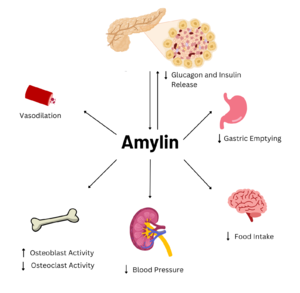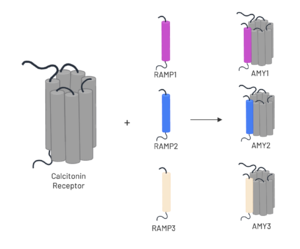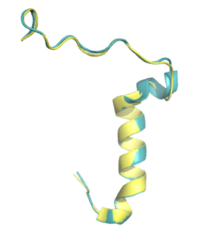User:Brynn Baker/Sandbox1
From Proteopedia
(Difference between revisions)
| Line 31: | Line 31: | ||
Y37 of amylin is amidated. The <scene name='10/1037516/Amidated_cterm/2'>amide group forms a hydrogen bond with the backbone of S129</scene> on the calcitonin receptor. All biological activity was lost when this amide group was experimentally removed<ref name="Cao">PMID:35324283</ref>. | Y37 of amylin is amidated. The <scene name='10/1037516/Amidated_cterm/2'>amide group forms a hydrogen bond with the backbone of S129</scene> on the calcitonin receptor. All biological activity was lost when this amide group was experimentally removed<ref name="Cao">PMID:35324283</ref>. | ||
=== K1 === | === K1 === | ||
| - | K1, a highly conserved residue of amylin, interacts with K141 on the calcitonin receptor via a water molecule<ref name="Cao">PMID:35324283</ref>. | + | K1, a highly conserved residue of amylin, <scene name='10/1037520/K1/1'>interacts with K141</scene> on the calcitonin receptor via a water molecule<ref name="Cao">PMID:35324283</ref>. |
=== T6 === | === T6 === | ||
| - | T6, a highly conserved residue of amylin in the disulfide loop, interacts with H302 on the calcitonin receptor<ref name="Cao">PMID:35324283</ref>. | + | <scene name='10/1037520/T6/1'>T6</scene>, a highly conserved residue of amylin in the disulfide loop, interacts with H302 on the calcitonin receptor<ref name="Cao">PMID:35324283</ref>. |
=== R11 === | === R11 === | ||
<scene name='10/1037516/R11/3'>R11</scene> is situated toward the N-terminal end of amylin’s main alpha helix and is packed against the residues at the N-terminus. This residue forms multiple interactions with various residues to keep the N-terminal end of the helix and the disulfide loop in place. R11 pulls on the backbones of C2 and C4 in the disulfide loop and interacts with the backbones of N3 and A8. It also attracts the hydroxyl group of Y372 of the calcitonin receptor. Furthermore, R11 stabilizes various nearby waters to form bridges between amylin and the receptor<ref name="Cao">PMID:35324283</ref>. | <scene name='10/1037516/R11/3'>R11</scene> is situated toward the N-terminal end of amylin’s main alpha helix and is packed against the residues at the N-terminus. This residue forms multiple interactions with various residues to keep the N-terminal end of the helix and the disulfide loop in place. R11 pulls on the backbones of C2 and C4 in the disulfide loop and interacts with the backbones of N3 and A8. It also attracts the hydroxyl group of Y372 of the calcitonin receptor. Furthermore, R11 stabilizes various nearby waters to form bridges between amylin and the receptor<ref name="Cao">PMID:35324283</ref>. | ||
Revision as of 21:03, 21 April 2024
Homo sapiens Amylin3 Receptor, AMYR3
| |||||||||||
References
- ↑ Hay DL, Chen S, Lutz TA, Parkes DG, Roth JD. Amylin: Pharmacology, Physiology, and Clinical Potential. Pharmacol Rev. 2015 Jul;67(3):564-600. PMID:26071095 doi:10.1124/pr.115.010629
- ↑ 2.0 2.1 Grizzanti J, Corrigan R, Casadesus G. Neuroprotective Effects of Amylin Analogues on Alzheimer's Disease Pathogenesis and Cognition. J Alzheimers Dis. 2018;66(1):11-23. PMID:30282360 doi:10.3233/JAD-180433
- ↑ 3.0 3.1 3.2 3.3 3.4 3.5 3.6 3.7 3.8 3.9 Cao J, Belousoff MJ, Liang YL, Johnson RM, Josephs TM, Fletcher MM, Christopoulos A, Hay DL, Danev R, Wootten D, Sexton PM. A structural basis for amylin receptor phenotype. Science. 2022 Mar 25;375(6587):eabm9609. PMID:35324283 doi:10.1126/science.abm9609
- ↑ Bower RL, Hay DL. Amylin structure-function relationships and receptor pharmacology: implications for amylin mimetic drug development. Br J Pharmacol. 2016 Jun;173(12):1883-98. PMID:27061187 doi:10.1111/bph.13496
Student Contributors
- Brynn Baker
- Emily Berkman
- Sepp Hall



